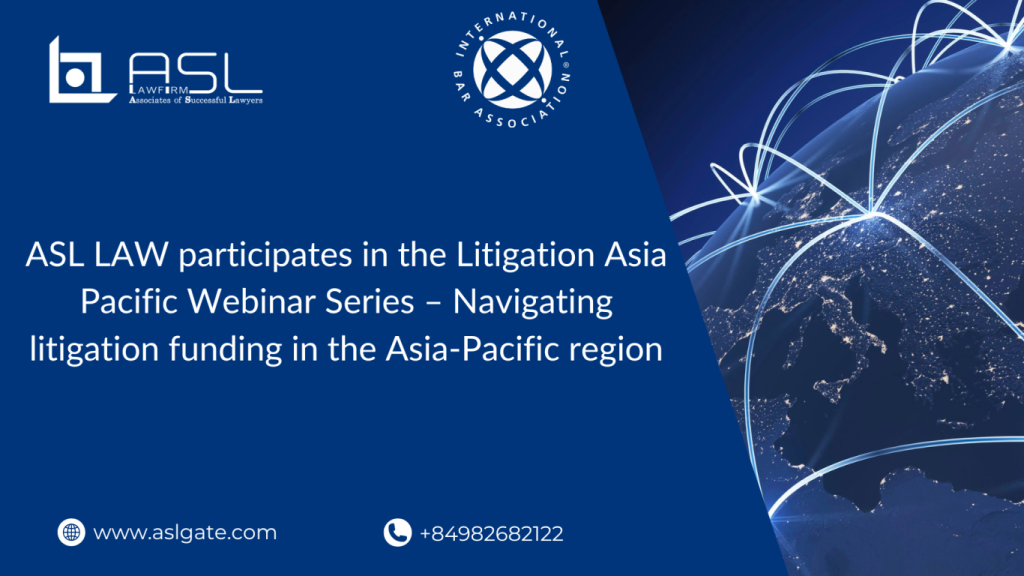The webinar “Navigating litigation funding in the Asia-Pacific region” focuses on litigation funding, also known as third-party funding, which has seen significant growth in recent years. While it is actively used in jurisdictions like Australia and Singapore, it remains regulated, restricted, or unaddressed in others, for example in Vietnam. Understanding litigation funding mechanisms and practices is vital for legal professionals dealing with cross-border or international disputes.
The panel includes experts from Australia and Singapore, offering diverse insights:
- Mr. Chris Pagent (Partner at Corrs Chambers Westgarth, Sydney, Australia);
- Ms. Toh Jia Yi (Partner at Allen & Gledhill LLP, Singapore);
- Mr. Jacob Varghese (CEO of Maurice Blackburn Lawyers, Melbourne, Australia);
- Ms. Kristen Smith (Portfolio Manager and Senior Investment Manager at Omni Bridgeway, Melbourne, Australia).
Concept of litigation funding and typical applications in Australia (Mr. Chris Pagent)
Litigation Funding Overview
Litigation funding is an arrangement where a third-party funder covers a claimant’s litigation costs and indemnifies them if they are required to pay the defendant’s costs. Initially limited to bankruptcy and insolvency cases, its use broadened significantly after a 2006 Australian High Court ruling that legitimized third-party funding.
Current Applications
Litigation funding is widely used in class actions, intellectual property disputes, construction cases, international arbitration, judgment enforcement, and asset recovery. It is particularly prevalent in class actions, where it accounted for 75% of new cases in 2018. While some claimants use it out of financial necessity, well-funded entities also employ it strategically.
How Funders Operate?
Funders evaluate cases through law firm referrals or internal development. Law firms seeking funding submit detailed budgets, and funders may commission expert reports. An investment committee typically assesses cases, and funders secure adverse cost insurance if approved. Funding agreements outline terms, including the funder’s commission, which depends on recovery size and litigation duration. Australia’s competitive market often sees claimants negotiating terms with multiple funders.
Legal Framework in Australia
Common fund orders (CFOs) are significant in Australia, enabling funders to recover a share of proceeds from all group members in class actions, even if they lack individual agreements.
The High Court will soon review the permissibility of CFOs and related solicitor-driven common fund orders. A ruling against CFOs could reduce funder returns, reshape the industry, and limit funded class actions, which corporate defendants would likely favor.
Litigation funding framework in Singapore (Ms. Toh Jia Yi)
Singapore’s legislation restricts the availability of third-party funding to arbitration proceedings and proceedings before the International Commercial Court, typically involving sophisticated entities. Regulations mandate that only professional funders with a minimum paid-up share capital or managed assets of S$5 million can qualify as third-party funders. This ensures a degree of protection and that parties are well-advised in seeking third-party funding arrangements.
Singapore’s framework is otherwise described as light-touch, relying on a combination of ethical rules, procedural rules, and guidelines issued by arbitration stakeholders to address specific issues such as conflicts of interest and cost implications.
Ethical Rules
Legal practitioners in Singapore must adhere to the Singapore Professional Conduct Rules, which require them to disclose the existence of any third-party funding arrangement to the court or tribunal and to other parties in the proceedings. This promotes transparency and mitigates potential ethical concerns.
Procedural Rules
Given the increasing prevalence of third-party funding in arbitration, major arbitral institutions have introduced procedural rules to address issues arising from such arrangements. A notable development is the introduction of the SIAC (Singapore International Arbitration Centre) Rules 2025, which include provisions on third-party funding:
- Tribunals are empowered to order disclosure of the details of third-party funding arrangements, including the funder’s interest in the proceedings’ outcome and their commitment to cover adverse cost liability.
- Tribunals ensure that funding arrangements do not create conflicts of interest, especially with tribunal members, by restricting parties from entering such arrangements after the tribunal is constituted.
International Commercial Court Rules
The framework has been extended to proceedings in the International Commercial Court. These rules empower the court to:
- Order third-party funders to provide security for the defendant’s costs.
- Impose cost orders on third-party funders at the court’s discretion.
Benefits and Implications
The availability of third-party funding enhances Singapore’s competitiveness as a hub for cross-border dispute resolution, particularly in arbitration. The transparency and safeguards in place bolster confidence in the fairness and integrity of legal proceedings involving third-party funding. Additionally, the arbitration community continues to establish best practices and maintain a list of funders adhering to these guidelines, ensuring ongoing improvements and regulatory oversight.
With its robust framework and focus on ethical and procedural transparency, Singapore is poised to remain an attractive destination for arbitration and cross-border dispute resolution.
Litigation funding In Australia (Mr. Jacob Varghese)
Litigation funding serves as a crucial mechanism for clients pursuing legal action in Australia, particularly given the high costs and financial risks under the country’s loser-pays system. For many claimants, even those with strong legal cases, the financial burden of litigation may be prohibitive. Litigation funding bridges this gap, enabling access to justice where it might otherwise be unattainable.
Key beneficiaries of litigation funding
Two primary categories of clients frequently benefiting from litigation funding are class action plaintiffs and insolvency practitioners.
- Class actions: Class actions typically involve numerous claimants, each with a relatively small share of the overall compensation. These plaintiffs often face well-funded corporate defendants with significant legal resources. Litigation funding plays a vital role in ensuring such cases proceed, as it allows law firms and third-party funders to finance the litigation costs. Without funding, class actions in Australia rarely proceed due to their complexity and expense.
- Insolvency practitioners: Insolvency practitioners, responsible for liquidating companies on behalf of creditors, often need to pursue claims against third parties but may lack the financial resources to do so. Since using company funds for litigation could negatively impact creditors, litigation funding provides a viable solution, allowing claims to proceed without depleting remaining assets.
The process of securing litigation funding
Securing litigation funding involves multiple steps and extensive due diligence by funders. The process typically includes:
a. Client or lawyer engagement: Insolvency practitioners may directly approach litigation funders, whereas in other cases, lawyers contact multiple funders to gauge interest.
b. Preparation by law firms: Law firms seeking funding must prepare:
- A detailed case analysis;
- A budget estimate;
- An estimate of potential damages.
c. Funders’ due diligence: Litigation funders conduct a rigorous internal review process, which can take months. For class actions, funders often wait until a law firm has secured control of the case before committing funding.
Litigation funding agreements
Litigation funding agreements create contractual relationships, usually between the litigation funder and the client, but sometimes also involving the lawyer. These agreements define key financial terms, including:
- Legal fee coverage: Funders typically pay legal fees in exchange for a percentage of the recovery.
- Lawyer involvement: Lawyers may defer some fees until case resolution, with an additional uplift to account for risk.
- Governance: The agreements specify decision-making procedures, settlement discussions, and dispute resolution mechanisms.
Challenges and risk mitigation in litigation funding
Despite its advantages, litigation funding presents several challenges:
- Conflicts of interest: Funders may prioritize early settlements over prolonged litigation for higher potential returns. Transparent agreements and aligned incentives help mitigate this risk.
- Budget and cost disputes: Litigation unpredictability can lead to disagreements over budgets. Regular communication and structured dispute resolution mechanisms are essential.
- Regulatory and market changes: The litigation funding landscape is evolving, with new regulations and market dynamics impacting agreements. Adaptability and staying informed are key.
Key considerations and financial metrics (Ms. Kristen Smith)
Litigation funding is a crucial mechanism that allows claimants to pursue legal actions without bearing the full financial risks. Funders assess cases not just on their legal merits but also on their commercial viability, ensuring that investments generate sufficient returns. This report outlines the key considerations funders evaluate, the financial metrics involved, and the process of collaboration between funders, clients, and lawyers.
Key factors in assessing a case
Litigation funders adopt an investment-focused approach when evaluating cases. The key considerations include:
- Strength of the case: Funders assess the legal merits of a claim, examining the cause of action, available evidence, and the strength of legal arguments. Documentary evidence is preferred over oral testimony due to its reliability.
- Expected value of the claim: The damages sought must be substantial enough to justify litigation costs and provide a viable return. Funders typically prefer claims where potential recovery is at least ten times the cost of litigation.
- Enforcement and recoverability: A strong case is meaningless if the defendant cannot pay. Funders analyze the defendant’s assets to ensure successful enforcement of a judgment.
- Funding needs: Claimants may require full or partial funding, including legal fees, disbursement coverage, and indemnities for adverse costs. Funders assess these needs before making a commitment.
- Legal team and client engagement: Funders evaluate the competence of the legal team and the engagement level of the claimant. A cooperative and commercially pragmatic claimant is preferred to avoid unnecessary complexities.
- Duration of the case: Longer cases are riskier. Funders assess jurisdictional factors, procedural hurdles, and likely litigation timelines to determine feasibility.
- Commercial return: As litigation funders operate as investors, they expect returns reflecting the risks involved. The return is structured as a multiple of the recovery, a percentage, or a combination of both.
- Risk diversification: Funders spread investments across multiple cases, industries, and jurisdictions to balance litigation risks and maintain portfolio stability.
Financial Metrics Funders Consider
Beyond case strength and commercial viability, funders rely on specific financial metrics:
- Return on Investment (ROI): Funders seek returns that justify capital risk. Lower-risk cases attract lower expected returns, while higher-risk cases require substantial compensation.
- Internal Rate of Return (IRR): The IRR measures investment efficiency over time. A high IRR indicates faster, more profitable returns, while prolonged litigation reduces attractiveness.
- Budget Evaluation: Funders scrutinize litigation budgets to ensure they are realistic and include contingencies. Flexible budgets are preferred to avoid renegotiations.
ASL Law is a leading full-service and independent Vietnamese law firm made up of experienced and talented lawyers. ASL Law is ranked as the top tier Law Firm in Vietnam by Legal500, Asia Law, WTR, and Asia Business Law Journal. Based in both Hanoi and Ho Chi Minh City in Vietnam, the firm’s main purpose is to provide the most practical, efficient and lawful advice to its domestic and international clients. If we can be of assistance, please email to [email protected].
ASL LAW is the top-tier Vietnam law firm for litigation and dispute resolution. If you need any advice, please contact us for further information or collaboration.

 Tiếng Việt
Tiếng Việt 中文 (中国)
中文 (中国) 日本語
日本語

